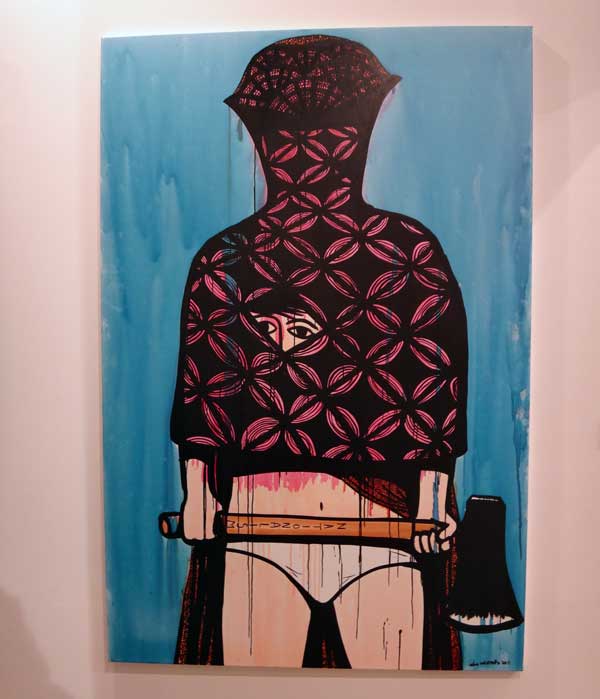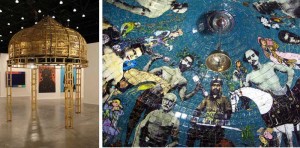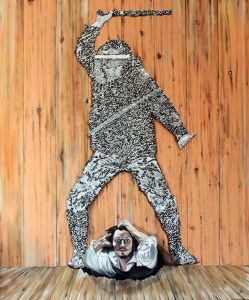Art Dubai keeps strong regional identity
The sixth edition of Art Dubai (held in the emirate, 21-24 March) brought together 75 dealers and a more international mix than in the past, with exhibitors coming from 32 countries including China, the US and five galleries from Indonesia, as part of the curated section of the fair.

Berlin’s Arndt gallery had to temporary remove "Nationalism", 2011, by Eko Nugroho and replaced it with a work by Khosrow Hassanzadeh (see below) but it was eventually put back up
Art Dubai is the epicentre of an art week that also included this year the new Design Days Dubai fair (18-21 March), a small satellite fair called Sikka (15-25 March), Sharjah’s March Meeting (17-19 March) and the Global Art Forum, the lecture and debate programme, which was first held in Doha (18-19 March) with the second leg in Dubai (21-24 March).
Dealers and visitors agreed that Art Dubai is becoming more sophisticated and constantly increasing in quality, thanks to the efforts of its director Antonia Carver, who in the past two years has eliminated the sort of garish abstract works that some galleries brought in the first years (and often found a ready market for). More conceptual, and sometimes “difficult” works were on show, such as an installation of shattered glass on the floor by Marya Kazoun, They Were There, 2011, with Janine Rubeiz gallery.

Khosrow Hassanzadehs' "Dome" looked innocent but in fact contained written references to Ali, the founder of Shia Islam
Dealers and visitors agreed that Art Dubai is becoming more sophisticated and constantly increasing in quality, thanks to the efforts of its director Antonia Carver, who in the past two years has eliminated the sort of garish abstract works that some galleries brought in the first years (and often found a ready market for). More conceptual, and sometimes “difficult” works were on show, such as an installation of shattered glass on the floor by Marya Kazoun, They Were There, 2011, with Janine Rubeiz gallery.
Most of the galleries brought Middle Eastern and Arab artists, giving the event a strong regional identity that many visitors commented upon favourably. Interestingly, however, despite the upheavals in the region, there was less politically engaged art than one might expect. This was partly down to self-censorship, as the exhibitors tend not to bring challenging works, and some submit images to the organisers before the fair. Even so, some pieces were taken down by the authorities before the fair started, although there was seemingly not much logic to the decisions. Berlin’s Arndt gallery had to remove Nationalism, 2011, by Eko Nugroho and replaced it with a work by Khosrow Hassanzadeh, which looked innocent but in fact contained written references to Ali, the founder of Shia Islam (according to the US State Department, the UAE is 80% Sunni). That was deemed unacceptable so Arndt put back the work by Nugroho, which remained up.

Shadi Al Zaqzouq's "You never loved me, father", 2011, priced at $30,000, was left up despite its image of Courbet pinned down by a man about to beat him
Sossy Dikijian, the art director of Artspace Dubai, had to remove Shadi Al Zaqzouq’s After Washing, 2011, a painting of a pair of underpants with the word “leave” in Arabic on them. The reference to the Egyptian revolution was clear, as this was what protestors had shouted in Tahrir Square. Another banned work was Zakaria Ramhani’s You were my only love, 2011, showing the scene where the Egyptian military dragged a woman through the street, exposing her blue bra and bare torso. “We were surprised [that this happened], as we are from Dubai and know the system here,” said Dikijian. But another work by Zaqzouq, You never loved me, father, 2011, priced at $30,000, was left up despite its image of Courbet pinned down by a man about to beat him.
Some galleries were not showing regional artists: the Goodman Gallery from South Africa had works by William Kentridge, while the Pace Gallery, on its first outing to the fair, was showing Keith Tyson, Keith Coventry and Zhang Huan.
On the whole, sales were good for many dealers, with the Beirut-based gallery The Running Horse selling 14 works by Alfred Tarazi (prices from $2,000 to $12,000). The London-New Delhi partnership Grosvenor Vadehra sold Syed Sadequain’s Couple in an Entrance, 1958, for $200,000 while the Paris-based Nathalie Obadia clocked up ten sales in the first two days, including Joana Vasconcelos’s bright felt wall-sculpture Montmartre, 2011, for $92,500.
Meanwhile, the quality at Design Days Dubai, held in the shadow of the towering Burj Khalifa, was mixed, with some very good galleries including Seomi from Korea, the London and Paris-based Carpenters Workshop Gallery and London’s Sarah Myerscough Fine Art, but others were of lesser quality. Sales were as mixed and ranged from “amazing” at the Carpenters Workshop, who reported placing Random International’s light piece, Swarm, 2011, for $210,000, as well as a raft of other sales. But for many, things were quiet. Myerscough found that clients “didn’t understand the prices”, while Seomi only sold one work—Myung Sun Kang’s Mermaid Stool, 2011, for $55,000.
By Georgina Adam
Source: www.theartnewspaper.com